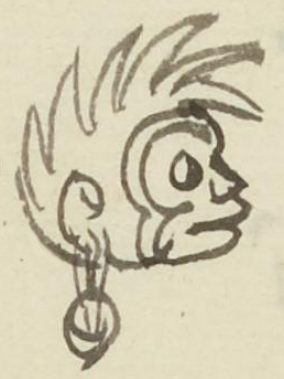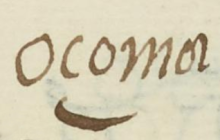Ozoma (MH639v)
This black-line drawing of a simplex glyph for the personal name Ozoma ("Monkey") shows a monkey's head in profile, looking to the viewer's right. The hair on its head is standing up and leaning somewhat forward. The animal's eye is open and it has an earring.
Stephanie Wood
The glyph for monkey very typically shows the hair (tzontli) on the top of its head standing up, and sometimes the hair is long and thick, and so very noticeable. Perhaps this portrayal of hair is meant to serve as a phonetic complement for the "zom" (from tzontli) in the middle of the word ozoma. The ozomatli is a day sign in the 260-day divinatory (religious) calendar called the tonalpohualli, so it was given as a name to babies born on its day. There was also a divine force or deity named Ozomatli, which, according to Desmond Morris (Monkey, 2013, 41), was "the companion spirit and servant of the god Xochipilli, the deity of music and dance. In paintings it is depicted dressed in malinalli herbs and with white, oval earrings with pointed ends." The wide-open eye of this particular version of ozomatli is also found in other manuscripts and may be, along with the hair, a diagnostic.
Typically, a calendrical name would not only have the day sign but also a companion number from 1 to 13. By 1560, it is not unusual to see such numbers dropping away, whether inadvertently or possibly suppressed in the colonial context where consulting the pre-contact divinatory calendar could upset the local clergy.
The presence of an earring is also apparent in the pre-contact ceramic stamp showing a monkey in association with the record Ozoma (MH485v), below. This diagnostic feature apparently had a deep history, along with the spiky hair on the top of the monkey's head.
Stephanie Wood
oçoma
Ozoma
Stephanie Wood
1560
Jeff Haskett-Wood
monkeys, monos, calendarios, tonalpohualli, días, deidades, deities, divinities, divine forces, ozomatli, nombres de hombres

ozoma(tli), monkey, https://nahuatl.wired-humanities.org/content/ozomatli
Mono
Stephanie Wood
Matrícula de Huexotzinco, folio 639v, World Digital Library, https://www.loc.gov/resource/gdcwdl.wdl_15282/?sp=361st=image.
This manuscript is hosted by the Library of Congress and the World Digital Library; used here with the Creative Commons, “Attribution-NonCommercial-ShareAlike 3.0 License” (CC-BY-NC-SAq 3.0).










